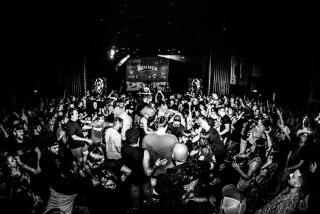Woodstock ‘94: Will it play with MTV crowd? : 25 years later, countdown is under way for August event. Key focus is security, safety.
- Share via
SAUGERTIES, N.Y. — It is hardly a mellow, tie-dyed happening. A quarter of a century after Woodstock, promoters are scrambling to leave little to chance this time on the fringes of this picturesque Hudson Valley village.
Construction crews have built two huge tanks on the Winston Farm, each holding 1 million gallons of water. Workers have stretched 25,000 feet of pipes leading to drinking stations. Security personnel have erected more than 10 miles of chain-link fence surrounding the property. Police will patrol on horseback and with all-terrain vehicles. Checkpoints will be set up on local roads. Contingency plans are in place for mass arrests of gate-crashers.
Medical experts have mapped locations for two field hospitals and helicopter landing pads. Tow truck operators have been recruited to remove any cars abandoned by fans, who will pay hefty fines to retrieve them. In the heat and humidity of late July, the assault against mosquitoes and poison ivy is about to begin.
The countdown to Woodstock ’94 on Aug. 12-14 is nearing completion. Amid the bustle of construction, it is hard to imagine the sign that graced Max Yasgur’s Farm, where the original Woodstock Festival was held, being placed on the Winston Farm.
“Don’t bother Max’s cows. Let them moo in peace,” that sign said.
Five presidents have passed, the Cold War has ended and the information superhighway has been created in the years since 400,000 young people gathered in rain, mud and tribalism on Yasgur’s farm in Bethel, N.Y.--about 60 miles from here--to cheer artists ranging from Jimi Hendrix to Ravi Shankar and to protest the Vietnam War.
The turnout was a huge surprise. Abandoned cars clogged all roads for miles, leading Wes Pomeroy, Woodstock’s security director, to lament: “Anyone who tries to come here is crazy. Sullivan County is a great big parking lot.”
Serious shortages of food and medical supplies raised fears of an epidemic. One hundred campfires alone were fed by fence posts. Physicians treated 4,000 people for illnesses, injuries and adverse drug reactions, although the crowd was peaceful. Hendrix closed Woodstock with a searing version of the National Anthem.
When it was all over, Yasgur looked over his littered acres. “What happened . . . was that these young people, together with our local residents, turned the Aquarian Festival into a dramatic victory for the spirit of peace, goodwill and human kindness,” he said.
A 19-year-old college student from Ohio added a codicil. “There was so much grass being smoked last night that you could get stoned just sitting there breathing,” she said. “It got so you didn’t even want another drag of anything.”
Twenty-five years later, the Woodstock generation is grayer, thicker at the waist and saddled with mortgages. Planners of Woodstock ‘94, realizing that nostalgia alone could be a tough sell to the MTV generation, are installing a six-acre, multimedia “Surreal Field.” Sponsors include Apple Computer and Philips Media, which will have a 90-station play tent where visitors can experience hands-on interactive technology.
The “Surreal Field” is aimed squarely at what its architect, Danny Socolof, calls “the first postgraduates of Nintendo University.”
“They are not content to sit back and watch. They want to participate,” he said.
Plans also call for up to 250,000 festival-goers at Woodstock ’94 to be screened: Not only are drugs and alcohol forbidden, so are video cameras, tape recorders, pets, stoves, grills and cooking utensils. Food is in the purview of the concessionaires.
The Woodstock Nation has met merchandising--and merchandising has won. The festival has the backing of PolyGram Diversified Entertainment. Tickets cost $138 each and have to be bought in groups of four. Portions of the concert--which will feature more than 30 groups, including Aerosmith, Johnny Cash, Crosby Stills and Nash, Bob Dylan and the Red Hot Chili Peppers--will be carried live on pay-per-view TV. Plans also include a concert movie, album and perhaps as a spin-off, a chain of Woodstock cafes. A commemorative plate will be offered on the QVC home shopping network.
At Seasons, a stationery store in Saugerties, the shelves are stocked with T-shirts, buttons, dog tags, posters, trading cards, beer steins, shot glasses and coffee mugs licensed by PolyGram. “I’m excited about it. . . . It has been very good for business,” said Susan Brilbeck, the store’s owner.
Business can use the boost. Unemployment has been high in the Hudson Valley after IBM laid off thousands of workers.
For many residents, the excitement is mixed with apprehension. Normally, the biggest event in Saugerties, a town of 18,500 people, is the annual garlic festival.
In an effort to reassure property owners, concert promoters held local meetings and pointed to extensive preparations by New York state officials, who do not want--especially in a year when Gov. Mario M. Cuomo is facing his toughest reelection fight--a repeat of problems of the original Woodstock.
But some anxiety remains. “We have had several meetings on security and the cops say they have 400 state police and 140 county police and town police,” said Ed Reppert, whose property borders the Winston Farm. “I asked how long it would take to get someone to my home, and they didn’t answer.”
More to Read
The biggest entertainment stories
Get our big stories about Hollywood, film, television, music, arts, culture and more right in your inbox as soon as they publish.
You may occasionally receive promotional content from the Los Angeles Times.










